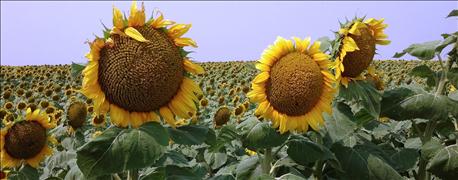December 1, 2016

Sunflower prices are following Chicago Board of Trade soy oil futures again after early harvest pressure. Prices had fallen on robust seed deliveries to crush plants from active producer selling in the late summer months, plus deliveries of previous contracted seed. Large amounts of seed were traded as producers took advantage of attractive prices and the need to free up storage for other crops. Producer selling will likely slow down given current pricing, unless storage is an issue, with the hope of a rally occurring in early 2017.

SUNNY OUTLOOK: Prices may be higher for sunflowers next year.
Looking at the global world vegetable oil situation, reports are still coming out indicating that oil supplies are expected to tighten significantly in the 2016-17 marketing year as world consumption outstrips production. Despite record vegetable oil production this year, and essentially over the past three years, world vegetable oil stocks have been drawn down for four consecutive years. Some are suggesting that world vegetable oil stocks will end up at the lowest levels since the 2011-12 season. This would allow world vegetable oil markets to firm up, with the market becoming more oil-driven rather than meal-driven. This is positive news for sunflower, as seed prices are primarily based on oil values.
Historically, small-market crops have always been priced above major commodities such as wheat, corn and soybeans. That has been necessary to ensure the volume of minor crop acres gets planted. If you look back at what happened in 2016 and looking forward to 2017, prices have settled into that historical trend once again. Small-market crop prices have declined somewhat, but not to the degree of the big three. As a result, companies within the sunflower industry report renewed interest from producers who have not planted sunflowers in a few years but are considering planting them in 2017 as they look for crops that pencil out.
No estimates are out yet on 2017 sunflower acres, but industry analysts believe that sunflower acres will increase given the interest they are hearing from producers. Based on historical usage, an increase in acres of 8% to 10% in 2017 can easily be added given current demand without impacting present prices to a great degree. More sunflower acres will be needed as USDA estimated 2016 production declined 16% from a year ago to 2.46 billion pounds due to lower sown acreage and yields. This represents a decrease of 465 million pounds below the 2015 harvest.
The impact on total supplies is tempered by carryover stocks of 235 million pounds, but crush is expected to increase from 1.14 billion pounds in the 2015-16 marketing year to 1.3 billion pounds in 2016-17 to fulfill market demand. This should draw down seed stocks to very tight levels by next fall.
From the looks of it, 2017 will be another challenging year in terms of marketing commodities. It will be important to watch the markets carefully to take advantage of market rallies. To keep up with price movement, go to sunflowernsa.com. As you prepare your crop budgets for 2017, take a look at oil sunflowers; they may be among your top earners.
Sanbakken is executive director of the National Sunflower Association.
You May Also Like




